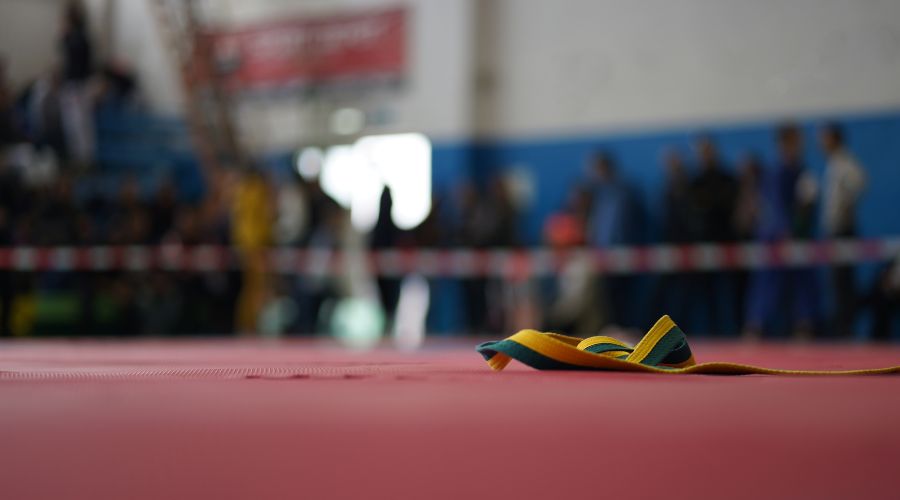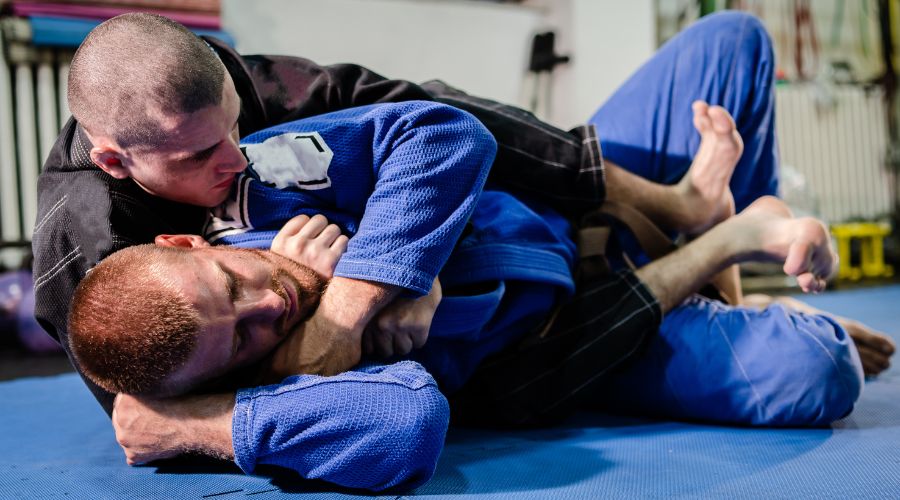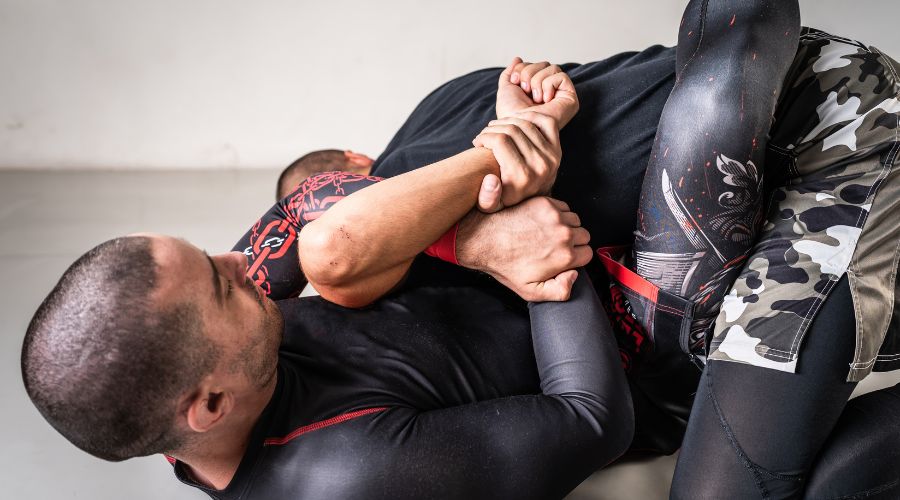Competition is the best way to test your skills and elevate your BJJ game to the next level. Rolling in the gym is one thing, but competing offers a different world of emotions. Aside from the technical and physical preparation, those of you looking to compete on the mats need to know what the BJJ points system is and how matches are scored.
The quickest way to win a BJJ match is to finish a submission and force the opponent to tap out. The scoring system awards positioning and ground dominance and decides the winner if a submission is not finished within the time limit. For example, takedowns and sweeps score 2 points, while dominant positions like mount and back mount will earn you 4 points.
Most, if not all, beginners will compete in the IBJJF organization and continue to do so for their entire careers. Being the biggest, they have set the standard in BJJ rules. This is why we will examine the IBJJF ruleset in more detail.
How To Win a BJJ Match?
As a combat sport focused on submissions, the best way to win in competition is to submit the opponent. Locking in a choke or a joint lock and forcing the other guy to tap is the most satisfying and convincing way to win.
But this is not always possible, and often the time runs out before any of the competitors finish a submission. This is why points are awarded for achieving and holding different positions under most BJJ rulesets. Then, at the end of the match, the competitor with the highest accumulation of points wins.
The third way to win is through advantage points if the result is a tie. The advantage points decide the match’s outcome only when the points are even.
Some organizations score gi and no-gi competitions differently, while others are submission only and do not award any points, like the EBI tournaments. The latter, though, is usually reserved only for very high-level grapplers. Let us call it the professional level of BJJ.
In this guide, we go through the scoring under the most popular rule sets in which anyone can participate.
IBJJF Scoring System

The most prominent BJJ organization is the IBJJF, and it holds the most tournaments worldwide by far. The IBJJF’s scoring system is also used in other organizations. There is an overwhelming chance that you will compete under this system more often than not if you want to test yourself in competition.
Here is a brief overview of how you can score points in an IBJJF match. All positions must be held for 3 seconds to earn the points.
2 points – Takedown
2 points – Sweep
2 points – Knee-on-belly
3 points – Guard pass
4 points – Mount
4 points – Rear mount/Back control
Takedown
2 points
Unlike most other grappling combat sports, the takedown is not highly valued in this ruleset. Taking the opponent down and controlling him will earn you only two points. To get them, the opponent must land on his back, side, or butt, and you must establish top position for at least 3 seconds.
Knee on Belly
2 points
As it’s clear from the name, the knee-on-belly position entails placing your knee or shin on the opponent’s belly or chest. Again, you need to hold the position for 3 seconds before you get the points.
Sweep
2 points
A sweep is performed when you reverse the position from the bottom and end up in top position. To get the 2 points, you need to start from full guard or half guard. Many competitors prefer to allow being taken down and perform a sweep to negate the 2 points earned by the opponent’s takedown.
Guard Pass
3 points
The only move to score 3 points is passing the guard. A guard pass means overcoming the opponent’s guard and ending up in side control, north south, or mount, all considered dominant positions, unlike the guards, which are neutral.
Mount and Back Mount
4 points

Mount is a dominant position achieved when sitting on your opponent’s belly or chest. You must have both knees or one knee and a foot on the ground for a mount to be scored.
Back Mount is where you are on your opponent’s back, and both of you face the ground. Both the mount and back mount are dominant positions for the attacker and are scored accordingly.
Back Control
4 points
Back control is very similar to back mount. Still, the difference is that the opponent sits on the floor instead of lying on his belly. You must have both legs inside his hips to get the precious 3 points awarded for back control.
Advantages
As mentioned, advantage points are awarded that come into play only when the score is a draw. You can earn advantage points in different scenarios.
The most common is when you cannot hold a position for the entire 3 seconds required for scoring. For example, you may pass the guard and go into side control. Still, the opponent escapes after two seconds, which gives you an advantage point.
Advantage points can also be earned for attempted and nearly finished submissions. Then referees are also allowed to award advantage points after the match is over but before the results are revealed, and in this way, settle the draw.
How to Lose a BJJ Match
As a competitive sport, BJJ also has a long list of things you are not allowed to do, and they are the quickest way to lose, aside from getting yourself in a submission.
Each belt level under IBJJF rules has different banned techniques, with a long list for white belts and a much shorter one for brown and black belts. But aside from them, there are many universal rules everyone must adhere to regardless of rank or suffer penalties or direct disqualification.
Disciplinary Penalties
Disciplinary fouls include rude language, gestures, or otherwise unsportsmanlike behavior. Severe abuses towards the opponent, referee, or audience may lead to direct disqualification.
Biting, pulling hair, intentional groin pressure, and striking in any form all fall into the disciplinary penalties category and are quick ways to get disqualified.
Technical Penalties

Technical penalties are further divided into lack of combativeness, serious penalties, and severe penalties.
The lack of combativeness is pretty obvious and is in place to incentivize action and is a way to label stalling tactics of all kinds.
Serious fouls also include a lot of tactics used to stall the action, like pulling guard without the establishment of a grip, sliding outside of the mat area to avoid combat, pushing the opponent outside of bounds intentionally, and many other points similar to this.
Severe fouls include more severe versions of serious fouls, like intentionally going out of bounds to escape a submission or committing a penalty to escape a submission.
The most important part of the severe penalties is perhaps the prohibited techniques. Slamming and suplexes, for example, are banned at all levels, including spinal locks and neck cranks. Then, there are different restricted techniques for each belt level and age group. Here is the full list:
/IBJJF banned moves list picture/
The list with fouls in all categories is rather long, and it’s an excellent idea to read all of them if you plan on competing to avoid unpleasant surprises.
ADCC Scoring Systems
The IBJJF is not the only BJJ organization in the world, and others have slight deviations in the scoring. The ADCC is the most prestigious organization, and the ADCC World Championship is considered the Olympics of submission grappling.
Again, each position must be held for 3 seconds, and you must be out of danger from submission before you earn the points. Here is how matches are scored in the ADCC:
2 points – Takedown
2 points – Mount
2 points – Takedown (ends with you in the guard or half guard)
2 points – Sweep (ends with you in the guard or half guard)
3 points – Passing the guard
3 points – Back mount with hooks
4 points – Clean Sweep (ends passed the guard)
4 points – Clean Takedown (ends passed the guard)
Overall, the rules of the ADCC place fewer restrictions on submissions. Still, many other things, like spiking the opponent’s head and slamming, are shared across all grappling-only organizations.
Summary
Knowing how BJJ competitions are scored is very important for everyone who plans to test themselves on the mats. Even regular spectators can enjoy the sport only after they understand the points system and recognize different tactics and strategies based on the ruleset.
